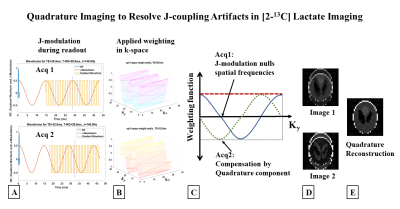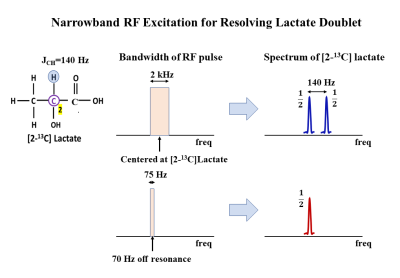Keshav Datta1 and Daniel Spielman1
1Department of Radiology, Stanford University, Stanford, CA, United States
1Department of Radiology, Stanford University, Stanford, CA, United States
Two
methods based on quadrature detection are presented to resolve J-coupling modulated
artifacts during imaging of spin-1/2 nuclei. A primary application is imaging
of [2-13C]Lactate in hyperpolarized [2-13C]Pyruvate experiments.

Figure 1 (A) Schematic of an RF pulse followed by gradient
waveform for EPI readout (FOV=128mm, 32x32 matrix, TE=28.4ms, readout=28.8ms)
highlights the evolution of J-modulation during imaging. (B) k-space weighting due
to J-modulation is significant in the slower phase encode direction (ky). (C) Spatial frequencies nulled due to J-coupling
evolution during readout (Acq1), compensated by acquiring a quadrature
component by delaying the acquisition time by 1/2J (Acq2). (D) Complex
combination of these two quadrature components restores the original image, (E).

Figure 2 Narrowband excitation for resolving J-coupling
induced doublet in [2-13C]Lac. Evolution of J-coupling during a
short RF pulse (500μs, 2kHz bandwidth) is negligible and hence results
in a doublet during signal collection (top row). A long narrow bandwidth pulse
(13.33ms, 75Hz), J/2 Hz off-resonance (70Hz), on the other hand, generates
in-phase and anti-phase coherences that combine to result in a singlet during
signal acquisition.